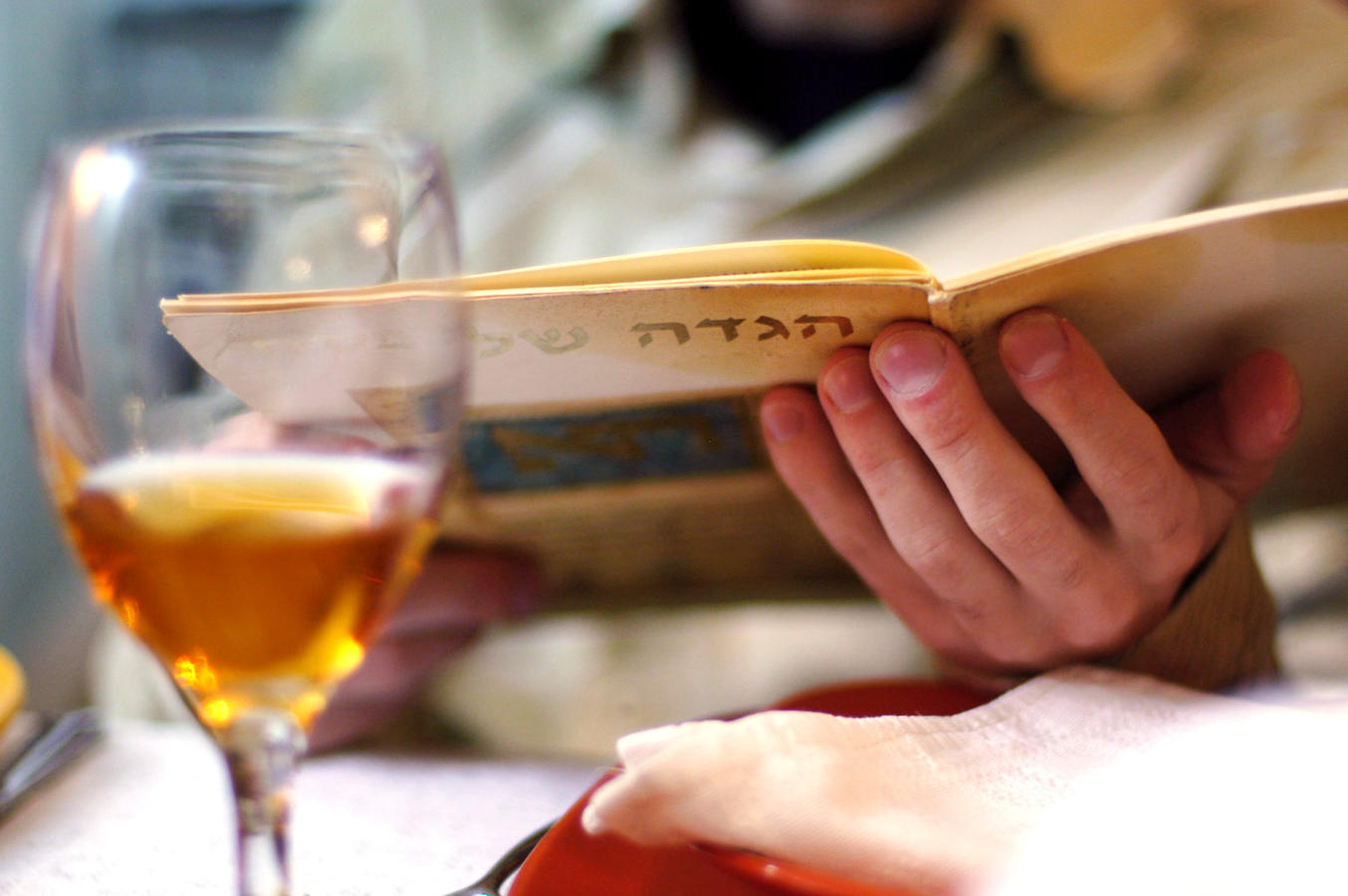The Passover Haggadah has, for centuries, been the text through which Jews have engaged in the retelling of the Jewish exodus from Egypt. Fulfilling the injunction to “Remember this day that you came forth from Egypt” (Exodus 13:3), and to recount this story to future generations (“Ve-higadeta le-vinkha“– “And you shall tell thy son,” Exodus 13:8), Jews across the globe read the during the Passover as a way of recapturing the spirit of freedom held by the Israelites following Moses out of Egypt, and celebrating the eternal notion of redemption and liberation.
The Haggadah — a collected work of blessings, prayers and excerpts from the Bible, Mishnah, and Midrash — was not written by one particular author, and was gradually supplemented by psalms and songs. The first printed version of the Haggadah was published in Guadalajara in 1482, a decade before the expulsion of the Jews from Spain. By the 16th century, there were approximately 25 printed versions; 300 years later, there were more than 1,000. These Haggadot (plural of Haggadah) vary in geographical origin, denominational orientation, political and social focus, and historical emphasis.
Various Haggadah manuscripts emerged around the world throughout the centuries (Darmstadt, ca. 1430; Venice, 1609; Amsterdam, 1737). The most famous is perhaps the Birds’ Head Haggadah, copied in Germany in the late 13th century. The unique nature of this Haggadah lies in the fact that most human figures are not depicted in realistic human form; they have birds’ heads, reflecting a popular medieval artistic style. Printed editions of the Haggadah, produced around the world, began appearing in the 15th century — each generation and region recreating the Haggadah in its own image.

Help us keep Jewish knowledge accessible to millions of people around the world.
Your donation to My Jewish Learning fuels endless journeys of Jewish discovery. With your help, My Jewish Learning can continue to provide nonstop opportunities for learning, connection and growth.
The Holocaust and Israel
Two monumental events that have reshaped the traditional Haggadah were the Holocaust and the establishment of the State of Israel. In the waning days of the Holocaust, survivors created A Survivor’s Haggadah, a remarkable illustrated Haggadah anticipating the first Passover after liberation from the Nazis. In this Haggadah, the traditional Passover liturgy, presenting the story of the Israelites’ liberation from Pharaoh in Egypt, was interwoven with the story of the Holocaust, and of the Jews who survived Hitler. The Survivor’s Haggadah, compiled by Yosef Dov Shenison, and decorated with poignant woodcuts created by fellow-survivor Miklos Adler, was reissued by the Jewish Publication Society in 2000. The Wolloch Haggadah in Memory of the Holocaust, published in Haifa in 1988, juxtaposes images from the Holocaust with the text of the traditional Haggadah, thereby linking the memory of the destruction of European Jewry with that of the Israelites’ enslavement and emancipation from Egypt.
The closing words of the Haggadah — “Next year in Jerusalem” — evoke the Jewish People’s perpetual longing to return to Zion. With the establishment of the State of Israel, traditional Jewish aspirations blended with modern Zionism. New Haggadot emerged with illustrations depicting the renewed Jewish settlement of the land of Israel as the fulfillment of this dream. One such Haggadah is the Rebirth of Israel Haggadah (1987), with text and illustrations by Chaya and David Harel. The fulfillment of religious and national aspirations is also manifested in the Jerusalem Haggadah, published in Haifa in 1968, reflecting the sense of elation that overwhelmed Israel following its victory in the Six Day War. The Haggadah represents the seder’s concluding statement, alluding to the return to Jerusalem as having finally (and fully) been realized.
The State of Israel also represented the ingathering of Diaspora Jews from around the world, a phenomenon represented in the Passover Haggadah as well. The art of ancient Diaspora hand-written Haggadot was revived in Israel by artist and calligrapher David Moss in the Shir Hama’alot LeDavid Haggadah (1987). Written and illustrated on parchment paper, this Haggadah celebrates the ingathering of exiles by bringing together a wide range of artistic and literary Diaspora traditions. The Haggadah of Memories, a traditional Haggadah, is accompanied by a large collection of childhood memories, recounted by members, of seders experienced in the various lands of the Diaspora.
Denominational Versions
As Jewish life has changed and evolved, so have denominational renditions of the Haggadah. Reform versions (An Open Door Haggadah, the official Reform movement Haggadah,and A Growing Haggadah, edited by Rabbi Mark Hurvitz of Congregation Etz Chaim, California) offer a contemplation of liberation and redemption in a political as well as spiritual context, emphasizing Jewish renewal. Reconstructionist versions (A Night of Questions, edited by Rabbi Michael Strassfeld and Rabbi Joy Levitt) offer provocative readings and commentaries, as well as suggestions for rituals, using inclusive, gender-neutral language.
The Feast of Freedom (Rachel Anne Rabbinowicz) is the official Conservative movement Haggadah. First published in 1982, it has a “new” translation, encourages the active involvement of all participants, and contains sections on the Holocaust and modern slavery. The Orthodox world has a plethora of new Haggadot, many offering the insights of a single well-known contemporary rabbi or translations of the commentary from a rabbinic figure from the past. Compiling the writings of many rabbis, a relatively new version is the Haggadah of the Roshei Yeshiva: Illuminating Thoughts from This Century’s Great Torah Leaders.
A cross-denominational version, published by the Shalom Hartman Institute in Jerusalem (A Different Night: The Family Participation Haggadah compiled by Noam Zion and David Dishon), employs various journalistic, fictional and rabbinic texts to engage the entire family in discussions exploring the various themes and expanding meanings of the Haggadah.
In the spirit of Jewish renewal, several Haggadot are still in a process of evolution and modification. Rabbi Hurvitz edits and prints a Haggadah every year, offering an electronic version that “can change at any time,” and can be read ” both linearly and hyper-textually” (www.davka.org). Secular humanist Jews also have their own Haggadah, The Liberated Haggadah: A Passover Celebration for Cultural, Secular, and Humanistic Jews, by Rabbi Peter Schweitzer and published by the Center for Cultural Judaism.
Political and Social Themes
The 1940s and 1950s marked the evolution of the traditional Haggadah into a text incorporating social and political realities, a process that still continues today. New Haggadot began appearing, outlining socialist, feminist, egalitarian, gay and lesbian, environmental, and other concerns. Kibbutz Haggadot (Ha-Kibbutz Ha-Artzi, Ha-Kibbutz Ha-Meuchad), produced by secular collective communities in Israel, tend to reflect the socialist — and often atheistic — views of kibbutz founders. They place more emphasis on nationalistic and seasonal elements revolving around spring, the harvest, the Exodus, peace, and the ingathering of the Jewish people in Israel. These Haggadot often abbreviate the original text, downplaying its religious
Universalist Haggadot, emphasizing social justice and peace, tend towards free adaptations of the original liturgy, attempting to appeal to a broad spectrum of readers and seder participants, to universalize the experience of the Exodus, and to apply it to present-day life. The Israelites’ slavery in Egypt becomes a metaphor for contemporary forms of oppression and social injustice, and the freedom gained by the Israelites is equated with social activism. The authors of Because We Were Slaves: A Concise Haggadah for All of Us (1999) state their intention to “share the seder with diverse Jewish and non-Jewish communities, to strengthen understanding within and among us, so it may also strengthen our commitment to work together for justice and peace.” Shalom Seders: Three Haggadahs (1984) includes a Jewish/Palestinian seder incorporating the biblical and Koranic versions of Hagar, Ishmael, Sarah, and Isaac, and accounts of Israeli and Palestinian suffering as well as mutual peacemaking efforts, and is aimed at the reconciliation of the children of Abraham.
Several feminist Haggadot have also come into existence. Towards Freedom: A Feminist Haggadah for Men and Women (1995) is defined as “a mystical interpretation of an ancient ritual,” using feminine imagery, drawings, and calligraphy, and mythic symbols belonging to the Jewish tradition. Believing that exodus is a recurring theme in life’s spiritual journey, author Heather Mendel strives for a future of freedom for all. The Dancing with Miriam Haggadah: A Jewish Women’s Celebration of Passover (1997) contains original prayers, commentary, poetry, music, and art. Traditional Passover symbols are interpreted and presented through a feminist sensibility, validating women’s life
Other Haggadot focusing on social and political concerns are (among many): The Anonymous Haggadah: A Synthesis of the Passover Ritual and Liturgy with the Twelve Steps of Recovery (1996), aimed at audiences recovering from alcohol and drug abuse; Haggadah for the Liberated Lamb (1988), issued by Vegetarian Books and linking the traditional Passover story with the liberation of all God’s creatures; and The Santa Cruz Haggadah (1992), an “Evolving Consciousness” Haggadah emphasizing self-liberation from that which enslaves us in our lives, and the significance of connecting with other groups lacking freedom or protection.
Children’s Haggadah
Yet another genre of Haggadot is the children’s Haggadah. In an attempt to make the story of Passover accessible and comprehensible, enabling children to participate in the seder, several Haggadot have been published with young readership in mind. Such is My Favorite Family Haggadah: A Fun, Interactive Passover Service for Children & Their Families (Shari Faden Donahue, 1995).
Taking into account the difficulty a long service presents for young children, this interactive Haggadah offers a 20-to-30-minute service designed especially for children and their families, featuring pictures, activities, and song. Another is Uncle Eli’s
-for-Kids Most Fun Ever Under-the-Table Passover Haggadah (Eliezer Lorne Segal, 1999). This humorous rendition presents the events and rituals of the seder in rhyming verse (“On all other nights / you would probably flip / if anyone asked you / how often you dip”), and offers whimsical color illustrations.
There are now more than 3,000 versions of the Passover Haggadah in existence, a fact indicating its tremendous popularity. The ancient seder ritual, observed each year by millions of Jews around the world, reminds us of the sacredness of time, and of the importance to remember and retell the story of the Israelites’ enslavement, Exodus, and emancipation. As Jewish life and thought continue to transform, more and more versions of this story will likely be produced in the future, each mirroring the evolution of the Jewish people.
Torah
Pronunced: TORE-uh, Origin: Hebrew, the Five Books of Moses.

Help us keep Jewish knowledge accessible to millions of people around the world.
Your donation to My Jewish Learning fuels endless journeys of Jewish discovery. With your help, My Jewish Learning can continue to provide nonstop opportunities for learning, connection and growth.




